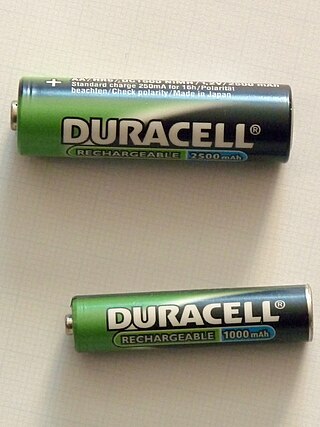Ampere-hour
Unit of electric charge From Wikipedia, the free encyclopedia
An ampere-hour or amp-hour (symbol: A⋅h or A h; often simplified as Ah) is a unit of electric charge, having dimensions of electric current multiplied by time, equal to the charge transferred by a steady current of one ampere flowing for one hour, or 3,600 coulombs.[1][2]
| ampere-hour | |
|---|---|
 Rechargeable batteries Top: AA battery (2500 mA⋅h) Bottom: AAA battery (1000 mA⋅h) | |
| General information | |
| Unit system | Non-SI metric unit |
| Unit of | Electric charge |
| Symbol | A⋅h, A h |
| Conversions | |
| 1 A⋅h in ... | ... is equal to ... |
| SI units | 3600 C |
| Elementary charges | 2.24694327×1022 e |
| CGS units | 1.0792528488×1013 statC |
The commonly seen milliampere-hour (symbol: mA⋅h, mA h, often simplified as mAh) is one-thousandth of an ampere-hour (3.6 coulombs).
Use
Summarize
Perspective
The ampere-hour is frequently used in measurements of electrochemical systems such as electroplating and for battery capacity where the commonly known nominal voltage is understood.
A milliampere second (mA⋅s) is a unit of measurement used in X-ray imaging, diagnostic imaging, and radiation therapy. It is equivalent to a millicoulomb. This quantity is proportional to the total X-ray energy produced by a given X-ray tube operated at a particular voltage.[3] The same total dose can be delivered in different time periods depending on the X-ray tube current.
To help express energy, computation over charge values in ampere-hour requires precise data of voltage: in a battery system, for example, accurate calculation of the energy delivered requires integration of the power delivered (product of instantaneous voltage and instantaneous current) over the discharge interval.[4] Generally, the battery voltage varies during discharge; an average value or nominal value may be used to approximate the integration of power.[5]
When comparing the energy capacities of battery-based products that might have different internal cell chemistries or cell configurations, a simple ampere-hour rating is often insufficient. For example, at 3.2 V for a lithium iron phosphate battery cell (LiFePO
4), the perceived energy capacity of a small UPS product that has multiple DC outputs at different voltages but is simply listed with a single ampere-hour rating, e.g., 8800 mAh, would be exaggerated by a factor of 3.75 compared to that of a sealed 12-volt lead-acid battery where the ampere-hour rating, e.g., 7 Ah, is based on the total output voltage rather than the internal cell voltage, so the 12-volt output of the example UPS product can actually deliver only about a third of the energy of the example battery, not a quarter more energy. But a direct replacement product for the example battery, in the same form factor and comparable output voltage and energy capacity but based on LiFePO
4, might also be specified as 7 Ah, here based on output voltage rather than cell chemistry. For consumers without an engineering background, these difficulties would be avoided by a specification of the watt-hour rating instead (or additionally).[citation needed]
In other units of electric charge
One ampere-hour is equal to (up to 4 significant figures):
- 3,600 coulombs
- 2.247 × 1022 elementary charges
- 0.03731 faradays
- 1.079 × 1013 statcoulombs (CGS-ESU equivalent)
- 360 abcoulombs (CGS-EMU equivalent)
Examples
- An AA size dry cell has a capacity of about 2,000 to 3,000 milliampere-hours.
- An average smartphone battery usually has between 2,500 and 6,000 milliampere-hours of electric capacity.
- Automotive car batteries vary in capacity but a large automobile propelled by an internal combustion engine would have about a 50-ampere-hour battery capacity.
- Since one ampere-hour can produce 0.336 grams of aluminium from molten aluminium chloride, producing a ton of aluminium required transfer of at least 2.98 million ampere-hours.[6]
See also
References
Wikiwand - on
Seamless Wikipedia browsing. On steroids.
